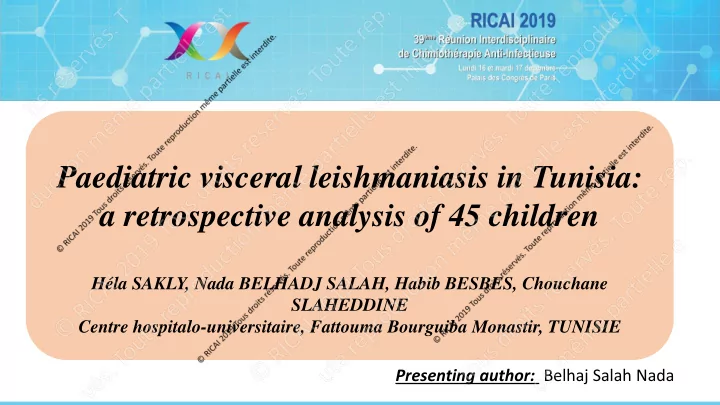

Paediatric visceral leishmaniasis in Tunisia: a retrospective analysis of 45 children Héla SAKLY, Nada BELHADJ SALAH, Habib BESBES, Chouchane SLAHEDDINE Centre hospitalo-universitaire, Fattouma Bourguiba Monastir, TUNISIE Presenting author: Belhaj Salah Nada
INTRODUCTION ➢ Visceral leishmaniasis (VL) is endemic in areas bordering the Mediterranean Sea. ➢ Rare in pediatric age. ➢ Caused by Leishmania infantum++++ ➢ Little information is available about infantile visceral leishmaniasis in Tunisia as regards incidence, diagnosis and management of the disease.
MATERIALS AND METHODS ➢ A retrospective study was conducted between 1994 to 2017. ➢ The epidemiologic, clinical, and therapeutic features were collected. ➢ VL was diagnosed by serology tests and/or the presence of amastigote of Leishmania in bone marrow aspirate. ➢ IFA and ELISA serology tests were performed according to World Health Organization (WHO) manual protocol using cultured promastigote of local L. infantum as antigen.
RESULTS ➢ The median age was 25 months (4 months-120 months). ➢ 78 % of patients were from areas evenly distributed in 25 rural or suburban areas, where stray dogs and sandflies exist. ➢ A tendency toward the onset of symptoms during the spring or summer was observed ( 67% of cases). ➢ The median time from the onset of symptoms to admission was 30 days (3 days-80 days).
Table 1: Clinical manifestation in visceral leishmaniasis hospitalized children Clinical characteristics N % Fever 43 97,1 Splenomegaly 42 94,3 Loss of weight 35 77,7 Oedema 15 33,3 Diarrhoea 9 20 Vomiting 8 17,7 Abdomen enlargement 3 6,6
➢ The detection of serum Leishmania antibodies by an immunofluorescent antibody test was positive in 77.2 % 97.90% 82% (27 cases). 77.70% 77.10% ➢ A bone marrow aspiration was obtained from all patients, and Leishmania amastigotes were detected in 18 cases (51.4%). ➢ Polymerase-chain – reaction (PCR) was positive in 11 cases (31.4%). FIGURE 2: HEMATOLOGICAL FINDINGS
➢ All patients were cured with meglumine antimonate. ➢ 30 patients noted reduction of spleen size — up to half of the initial palpated size within a median of 13 days (range, 6 – 30 days) after treatment was begun.
2 2 1 1 1 RASH DRY CAUGH TACHYCARDIA DIARRHEA INDURATION AT THE INJECTION SITE Fig. Adverse effects of meglumine antimonite in visceral leishmaniasis hospitalized children
DISCUSSION ➢ In the present study, fever, splenomegaly and hepatomegaly were the most prevalent clinical signs and anemia, leukopenia, and thrombocytopenia were the prominent laboratory findings, which agrees with previous studies [1,2] . ➢ Diarrhoea was observed as a non-specific symptom in 20 % of these children. This sign was previously reported in 23% of children with VL hospitalized in Tehran Pediatric Medical Center [3] . 1- Sarkari B, Naraki T, Ghatee MA, et al. Visceral leishmaniasis in Southwestern Iran: a retrospective clinicohematological analysis of 380 consecutive hospitalized cases (1999 – 2014). PLoS One 2016; 11: e0150406. 2- Miao R, Wang Z, Guo Q, et al. Clinical and epidemiologic features of visceral leishmaniasis in children in southwestern China: a retrospective analysis from 2001 to 2015. Pediatr Infect Dis J 2017; 36: 9 – 12. 3-Bokaie S, Sharifi L, Mamishi S, et al. A case series study on clinical and epidemiologic aspects of Kala azar in patients referred to the Children’s Medic al Center since 1991 to 2003. Iran J Epidemiol 2006; 1: 21 – 26
DISCUSSION ➢ Despite the use of alternative drugs to treat leishmaniasis, Glucantime still plays an essential role in the treatment of the disease in Tunisia. ➢ In studies conducted in Ardebil [4] and southwest Iran [1] , Glucantime was used in 96% and 97.1% of patients, respectively. ➢ In this study, bone marrow samples or their culture were positive in 51,4% of cases. ➢ The sensitivity of bone marrow aspiration does not to appear consistent in diagnosing this disease in various studies and depends on sampling method, culture, and timing of sampling. 4- Mohammadi KK, Mohebali M, Mamishi S, et al. Epidemiological characteristics of Kala-azar in hospitalized patients in Ardebil province [in Persian]. J Sch Public Health Inst Public Health Res 2003; 6: 11 – 24
CONCLUSIONS: CONCLUSION ➢ Visceral leishmaniasis in pediatric age is relatively rare in Tunisia. ➢ Because of its distribution pattern, identifying infected focal points, clinical manifestation, early diagnosis and treatment have a significant role in controlling the disease and its mortality. ➢ Despite recent reports on decreased responses to antimonial drugs of patients with Mediterranean VL, meglumine antimoniate treatment is still highly effective in Tunisia.
Thank you for your attention
Recommend
More recommend